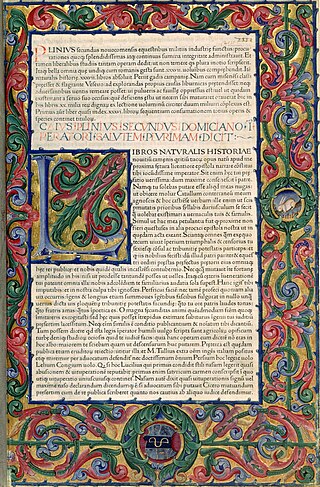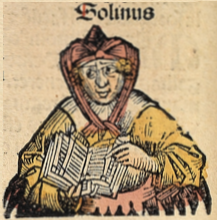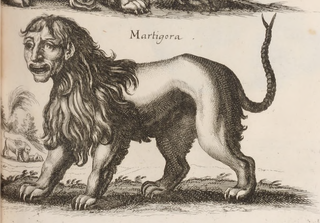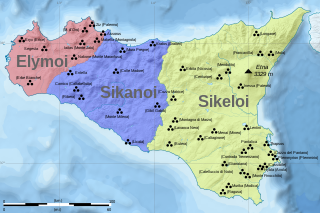
Gaius Plinius Secundus, known in English as Pliny the Elder, was a Roman author, naturalist, natural philosopher, and naval and army commander of the early Roman Empire, and a friend of the emperor Vespasian. He wrote the encyclopedic Naturalis Historia, a comprehensive thirty-seven-volume work covering a vast array of topics on human knowledge and the natural world, which became an editorial model for encyclopedias. He spent most of his spare time studying, writing, and investigating natural and geographic phenomena in the field.

The phoenix is an immortal bird that cyclically regenerates or is otherwise born again. While it is part of Greek mythology, it has analogs in many cultures, such as Egyptian and Persian mythology. Associated with the sun, a phoenix obtains new life by rising from the ashes of its predecessor. Some legends say it dies in a show of flames and combustion, while others that it simply dies and decomposes before being born again. In the Motif-Index of Folk-Literature, a tool used by folklorists, the phoenix is classified as motif B32.

Gaius Plinius Caecilius Secundus, better known in English as Pliny the Younger, was a lawyer, author, and magistrate of Ancient Rome. Pliny's uncle, Pliny the Elder, helped raise and educate him.

The Natural History is a Latin work by Pliny the Elder. The largest single work to have survived from the Roman Empire to the modern day, the Natural History compiles information gleaned from other ancient authors. Despite the work's title, its subject area is not limited to what is today understood by natural history; Pliny himself defines his scope as "the natural world, or life". It is encyclopedic in scope, but its structure is not like that of a modern encyclopedia. It is the only work by Pliny to have survived, and the last that he published. He published the first 10 books in AD 77, but had not made a final revision of the remainder at the time of his death during the AD 79 eruption of Vesuvius. The rest was published posthumously by Pliny's nephew, Pliny the Younger.

Gaius Julius Solinus, better known simply as Solinus, was a Latin grammarian, geographer, and compiler who probably flourished in the early 3rd century AD. Historical scholar Theodor Mommsen dates him to the middle of the 3rd century.

Thule is the most northerly location mentioned in ancient Greek and Roman literature and cartography. Modern interpretations have included Orkney, Shetland, Northern Scotland, the island of Saaremaa (Ösel) in Estonia, and the Norwegian island of Smøla.

The manticore or mantichore is a legendary creature from ancient Persian mythology, similar to the Egyptian sphinx that proliferated in Western European medieval art as well. It has the head of a human, the body of a lion, and the tail of a scorpion or a tail covered in venomous spines similar to porcupine quills. There are some accounts that the spines can be launched like arrows. It eats its victims whole, using its three rows of teeth, and leaves no bones behind.
Hanno the Navigator was a Carthaginian explorer who lived during the fifth century BC, known for his naval expedition along the coast of West Africa. However, the only source of said voyage is a periplus translated into Greek.

Scandza was described as a "great island" by Gothic-Byzantine historian Jordanes in his work Getica. The island was located in the Arctic regions of the sea that surrounded the world. The location is usually identified with Scandinavia.

The Sicani or Sicanians were one of three ancient peoples of Sicily present at the time of Phoenician and Greek colonization. The Sicani dwelt east of the Elymians and west of the Sicels, having, according to Diodorus Siculus, the boundary with the last in the ancient Himera river (Salso) after a series of battles between these tribes.

The Hilleviones were a Germanic people occupying an island called Scatinavia in the 1st century AD, according to the Roman geographer Pliny the Elder in Naturalis Historia, written circa 77 AD. Pliny's Scatinavia is generally believed to have referred to the Scandinavian peninsula, which in the 1st century AD had not yet been fully explored by the Romans and was therefore described as an island. Pliny wrote that it was an island "of a magnitude as yet unascertained". The Hilleviones lived in the only part of the island that was known, and according to Pliny, they thought of their 500 villages as a separate (alterum) world.
The Medicina Plinii or Medical Pliny is an anonymous Latin compilation of medical remedies dating to the early 4th century AD. The excerptor, saying that he speaks from experience, offers the work as a compact resource for travelers in dealing with hucksters who sell worthless drugs at exorbitant prices or with know-nothings only interested in profit. The material is presented in three books in the conventional order a capite ad calcem, the first dealing with treatments pertaining to the head and throat, the second the torso and lower extremities, and the third systemic ailments, skin diseases, and poisons.

In Greco-Roman geography, the Riphean Mountains were a supposed mountain range located in the far north of Eurasia. The name of the mountains is probably derived from Ancient Greek: ῥιπή. The Ripheans were often considered the northern boundary of the known world. As such, classical and medieval writers described them as extremely cold and covered in perennial snow. Ancient geographers considered the Ripheans the source of Boreas and several large rivers. The location of the Ripheans, as described by most classical geographers, would correspond roughly with the Volga region of modern-day Russia.

Various species of mythical headless men were rumoured, in antiquity and later, to inhabit remote parts of the world. They are variously known as akephaloi or Blemmyes and described as lacking a head, with their facial features on their chest. These were at first described as inhabitants of ancient Libya or the Nile system (Aethiopia). Later traditions confined their habitat to a particular island in the Brisone River, or shifted it to India.

White Aethiopians is a term found in ancient Greco-Roman literature, which may have referred to various light-complexioned populations inhabiting the Aethiopia region of antiquity. The exonym is used by Pliny the Elder, and is also mentioned by Pomponius Mela, Ptolemy and Orosius. These authorities do not, however, agree on the geographical location of the White Aethiopians.
The Marsaci or Marsacii were a tribe in Roman imperial times, who lived within the area of the Rhine–Meuse–Scheldt delta, under Roman domination.

Chryse and Argyre were a pair of legendary islands, located in the Indian Ocean and said to be made of gold and silver. They took their name from the Greek words for gold (chrysos) and silver (argyros).
Aracynthus was a range of mountains in Aetolia, the exact position of which is uncertain. It was said to run in a south-easterly direction from the Achelous River to the Evenos, and separating the lower plain of Aetolia near the sea from the upper plain above the lakes Hyria and Trichonida.
The gens Rubria was a plebeian family at ancient Rome. Members of this gens are first mentioned in the time of the Gracchi, but they did not rise to prominence until imperial times. The first of the Rubrii to obtain the consulship was Rubrius Gallus, some time before AD 68.
The gens Statia was a minor plebeian family at ancient Rome. Members of this gens are first mentioned in the early decades of the Republic, but the name does not appear again in history until the time of Cicero. The Statii remained relatively undistinguished until the reign of Trajan, when Lucius Statius Aquila was raised to the consulship.














